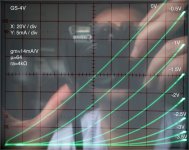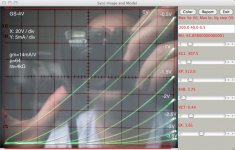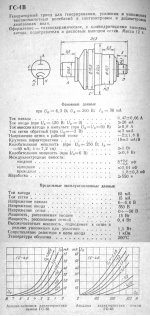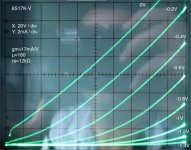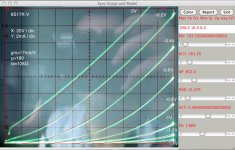I think this triode was been mentioned before, but I was looking at options for the expensive 6SC7 as a first valve for a RIAA preamp and found the GS-4V high-frequency triode. Nice little chap, but struggled to get some info on the web, so decided to plot my own curves.
Some info is available here:
GS4V | Tubes Information
Not sure how this triode will sound but curves look quite nice, has anyone tried it?
Attached are the plotted curves, the original datasheet in russian and my SPICE model. I think the model comes up pretty good, but need to tweak the capacitances in the .lib file.
Any russian speaker can kindly translate the capacitances (assuming they are in the scanned datasheet attached?
Well hope this is helpful to anyone out there...
Cheers,
Ale
Some info is available here:
GS4V | Tubes Information
Not sure how this triode will sound but curves look quite nice, has anyone tried it?
Attached are the plotted curves, the original datasheet in russian and my SPICE model. I think the model comes up pretty good, but need to tweak the capacitances in the .lib file.
Any russian speaker can kindly translate the capacitances (assuming they are in the scanned datasheet attached?
Well hope this is helpful to anyone out there...
Cheers,
Ale
Attachments
Ale,
Thanks for those curves. I use the GS-4V as a driver for a GU-15 SE amp. It is a nice sounding tube with no microphonics. Probably work real nice as a grid bias RIAA first tube.
Matt
Hi Matt,
Good to know they are not microphonic
Ale,
My operating points were dictated by replacing a 6F4 acorn I had built the amp around. First went in a 6S17K-B planer, which was nice. But the plate choke I'm using worked better with the GS-4V. So I ended up with Plate to ground voltage on the GS-4B of 243V, Cathode to ground, Vbias 3.9V, which over 570 ohms cathode resistor means plate current is 6.8mA, and plate dissipation is 1.63W. It sounded so good I haven't messed with it. I agree higher current looks much better, but I cannot support more than 10ma in the compromised circuit it is in. I would like use them as P-P outputs to see how hot they can go without forced air cooling. As you can imagine at the operating point above they don't get super hot.
Matt
My operating points were dictated by replacing a 6F4 acorn I had built the amp around. First went in a 6S17K-B planer, which was nice. But the plate choke I'm using worked better with the GS-4V. So I ended up with Plate to ground voltage on the GS-4B of 243V, Cathode to ground, Vbias 3.9V, which over 570 ohms cathode resistor means plate current is 6.8mA, and plate dissipation is 1.63W. It sounded so good I haven't messed with it. I agree higher current looks much better, but I cannot support more than 10ma in the compromised circuit it is in. I would like use them as P-P outputs to see how hot they can go without forced air cooling. As you can imagine at the operating point above they don't get super hot.
Matt
Ale, the claimed grid-anode capacitance is 1.8pF but as this is a UHF triode I would be a bit skeptical about this at AF. If you are using it as RIAA first stage, I wouldn't bother using it at high current as it will probably be quiet anyway and at low current it will likely self-bias which means you can simply ground the cathode avoiding the problem of the heater/cathode connection. Anatoliy will be able to help, no doubt.
Thanks guys for the advice. Much appreciated!
Here is another high-frequency russian triode: 6S17K-V. This is a very high-mu and was challenging for my tracer (difficult to stabilise with fixed bias and very small grid steps signal).
Looks like mu is very high on this one, quite attractive from a gain perspective but anode resistance is around 10-12k. Could be an option as well?
Spice model I came up with is reasonably ok, hard to fit the curves on this one!
Cheers,
Ale
Here is another high-frequency russian triode: 6S17K-V. This is a very high-mu and was challenging for my tracer (difficult to stabilise with fixed bias and very small grid steps signal).
Looks like mu is very high on this one, quite attractive from a gain perspective but anode resistance is around 10-12k. Could be an option as well?
Spice model I came up with is reasonably ok, hard to fit the curves on this one!
Cheers,
Ale
Attachments
- Status
- This old topic is closed. If you want to reopen this topic, contact a moderator using the "Report Post" button.
- Home
- Amplifiers
- Tubes / Valves
- GS-4V High-mu russian triode for RIAA preamp
